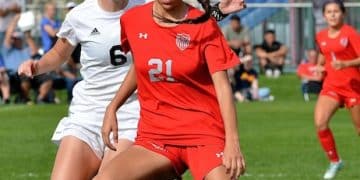The Impact of Specialization on Youth Athletes: Harming Long-Term Development?

The impact of specialization on youth athletes is a complex issue, with early focus potentially hindering long-term development by increasing injury risk, burnout, and limiting the acquisition of diverse athletic skills.
The allure of scholarships, professional careers, and athletic glory often pushes young athletes to specialize in a single sport at an early age. But is this early focus truly beneficial, or is it doing more harm than good? Let’s explore the impact of specialization on youth athletes: Is early focus harming long-term development?
The Rising Trend of Early Sports Specialization
Early sports specialization, the practice of focusing on a single sport year-round from a young age, has become increasingly prevalent in the United States. This trend is driven by various factors, including the desire for competitive advantage, parental aspirations, and the belief that early specialization is necessary to achieve elite status.
However, the long-term consequences of such intense focus are a growing concern among sports medicine professionals, coaches, and child development experts. It’s crucial to understand the multifaceted nature of this trend and evaluate its true impact on young athletes.
What Drives Specialization?
Several factors contribute to the increasing trend of early sports specialization:
- Pressure to Excel: The competitive atmosphere in youth sports often leads parents and coaches to encourage early specialization, believing it provides a head start.
- Scholarship Aspirations: The dream of securing college athletic scholarships motivates many young athletes to focus intensely on a single sport.
- Professional Ambitions: For some, early specialization is seen as a pathway to a professional athletic career.
Are these aspirations justified? The following sections will delve into the potential downsides of this strategy.
Physical Risks: Injury and Overuse
One of the most significant concerns associated with early sports specialization is the increased risk of overuse injuries. Repetitive movements and constant training in a single sport can place excessive stress on developing bones, muscles, and joints.
This can lead to a variety of injuries that could keep the young athlete sidelined or lead to chronic problems later in life. But are the potential risks worth the gains?

Common Overuse Injuries
Early specialization increases the likelihood of suffering from a variety of overuse injuries, including:
- Stress Fractures: Small cracks in the bone caused by repetitive impact.
- Tendonitis: Inflammation of the tendons due to overuse.
- Growth Plate Injuries: Damage to the areas of growing tissue near the ends of long bones, which can affect proper development.
These injuries not only sideline athletes but can also have long-term consequences for their physical health.
Psychological Burnout and Reduced Enjoyment
Besides physical risks, early specialization in sports can take a toll on a child’s mental and emotional well-being. The pressure to perform, coupled with the lack of variety and free play, can lead to burnout, anxiety, and a diminished love of the sport.
It is important to consider the potential damage to a child’s love for their sport when contemplating an early specialization. Does a single focus breed enjoyment, or resentment?
The Importance of Free Play
Unstructured play is essential for children’s development. It allows them to explore different activities, develop creativity, and build social skills. By limiting exposure to various sports and activities, early specialization deprives children of these valuable experiences.
Developmental Benefits of Multisport Participation
Engaging in multiple sports offers a range of developmental benefits that specialization simply can’t replicate. Different sports require different skills, movements, and strategies, promoting well-rounded athletic development.

The varied experiences and challenges of playing multiple sports can lead to greater overall athleticism, improved coordination, and reduced risk of injury. Let’s explore these benefits in more detail.
Cross-Training and Skill Transfer
Participating in multiple sports provides a form of cross-training that enhances overall athleticism. Skills learned in one sport can often transfer to another, improving coordination, balance, and agility.
- Enhanced Coordination: Different sports challenge different muscle groups and movement patterns, leading to improved overall coordination.
- Improved Agility: The need to adapt to different sports and situations enhances agility and reaction time.
- Reduced Injury Risk: Cross-training strengthens different muscle groups, reducing the risk of overuse injuries associated with specializing in a single sport.
Long-Term Athletic Success: The Role of Diversification
While early specialization might seem like a direct path to athletic success, research suggests that diversification in youth sports can actually lead to greater long-term achievement. Athletes who participate in multiple sports during childhood and adolescence tend to have longer, more successful careers.
Can exploring different sports actually benefit future elite athletes? Let’s take a closer look.
Delayed Specialization: A More Effective Approach?
Delayed sport specialization, waiting until later in adolescence to focus on a single sport, allows children to develop a broader range of skills, reduces the risk of burnout and overuse injuries, and may ultimately lead to greater long-term success.
Strategies for Promoting Healthy Athletic Development
Shifting away from early specialization requires a collaborative effort involving parents, coaches, and sports organizations. Creating a culture that values well-rounded development, enjoyment, and long-term health is crucial.
Promoting a healthy environment will foster a life-long love of sports over narrow specialization. But how can stakeholders help?
- Encourage Multisport Participation: Parents and coaches should encourage children to participate in a variety of sports and activities.
- Focus on Skill Development: Emphasize fundamental skill development over winning at all costs.
- Prioritize Fun and Enjoyment: Make sure that sports remain enjoyable for young athletes.
Conclusion
While the pressure to specialize early in sports can be intense, the evidence suggests that a diversified approach is more beneficial for long-term athletic development. Focus on multiple sports and a love of the game rather than immediate gain. By prioritizing well-rounded development and the health of young athletes, we can foster a lifelong passion for sports.
| Key Point | Brief Description |
|---|---|
| 🤕 Injury Risk | Early specialization increases the risk of overuse injuries. |
| 🔥 Burnout | Intense focus can lead to psychological burnout and decreased enjoyment. |
| 🌱 Well-Rounded Development | Multi-sport participation fosters better overall athletic skills. |
| 🏆 Long-Term Success | Diversification may lead to greater and longer athletic success. |
Frequently Asked Questions
It refers to the practice of focusing on a single sport year-round from a young age, often with the exclusion of other activities. This trend is becoming increasingly common in youth sports.
The major physical risks include overuse injuries such as stress fractures, tendonitis, and growth plate injuries. These can have long-term consequences for athletic health.
Participating in multiple sports promotes well-rounded athletic development, improves coordination and agility, reduces the risk of injury, and can prevent psychological burnout.
This involves waiting until later in adolescence to focus on a single sport. This allows for broader skill development and reduces risks associated with early specialization.
They should encourage participation in a variety of sports, focus on skill development, prioritize fun and enjoyment, and create a culture that values long-term health over short-term gains.
Conclusion
In conclusion, while the allure of athletic success might push young athletes toward early specialization, the long-term physical, psychological, and developmental benefits of multi-sport participation are undeniable. Embracing a balanced approach can lead to healthier, happier, and ultimately more successful athletes.





